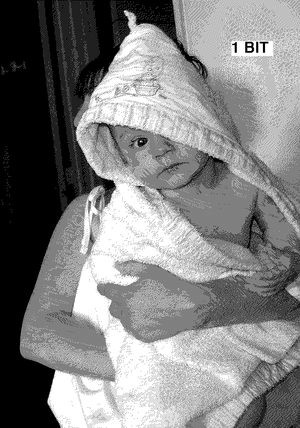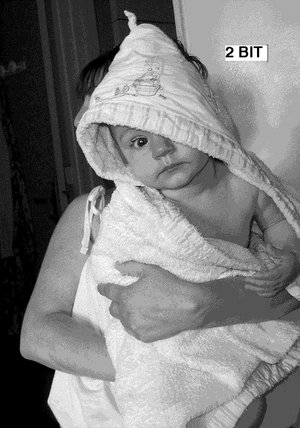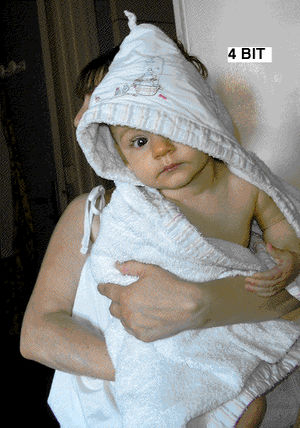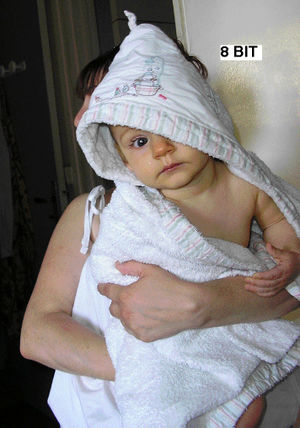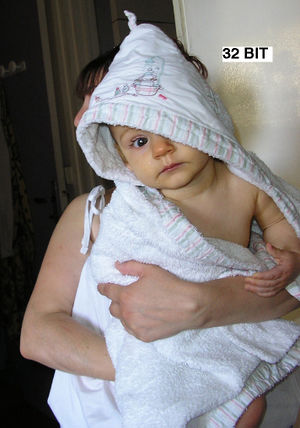|
|
| (23 intermediate revisions by 2 users not shown) |
| Line 2: |
Line 2: |
| | ==In Class== | | ==In Class== |
| | | | |
| − | * Audio Effects Presentations
| |
| − | * Intro to digital theory
| |
| | * Rendering in Premiere | | * Rendering in Premiere |
| | | | |
| − | ==Digital Theory==
| + | {{Template:Digital Theory}} |
| | | | |
| − | Word of the Day
| |
| − | Analog
| |
| − | How stuff works - How Analog and Digital Recording Works
| |
| | | | |
| − | Analog vs. Digital the arguments in a nutshell
| + | {{Template:Binary Numbers}} |
| − | {| | |
| − | | Analog || Digital Good
| |
| − | |-
| |
| − | | Infinite dynamic quantization (infinite resolution) || Quantization error fix - more bit depth/oversampling
| |
| − | |-
| |
| − | | Good? - The warming effects 'we're used' to from tape compression. ||Good?-'Perfect' reproduction of high frequencies - 'soundz harsh fix - 'using warm-sounding mikes and preamps (tubes)'
| |
| − | |-
| |
| − | |Bad - Tape noise and generation loss || Good - 'no generation loss'
| |
| − | |-
| |
| − | |Bad - 'Cheap recordings sound cheap' || Good - 'cheap recordings sound good but digital'
| |
| − | |}
| |
| − | * 'anything in quotes is what I like to call an opinion
| |
| | | | |
| − |
| + | {{Template:Color Depth}} |
| − | Other Opinions
| |
| | | | |
| − | analog winner http://www.segall.com/atr.html
| + | {{Template:Binary Math}} |
| | | | |
| − | analog winner http://www.digido.com/analog_versus_digital.html
| + | ==Premiere Audio Demo== |
| − | | + | [[Premiere Audio Demo]] |
| − | comparison http://www.outersound.com/osu/recording/
| |
| − | | |
| − | ana-dig.html
| |
| − | Number Systems
| |
| − | {|
| |
| − | |Hexadecimal Base 16 ||Decimal Base 10 || Octal Base 8 || Binary Base 2
| |
| − | |-
| |
| − | |0 || 0 || 0 || 0000
| |
| − | |-
| |
| − | |1 || 1 || 1 || 0001
| |
| − | |-
| |
| − | |2 || 2 || 2 || 0010
| |
| − | |-
| |
| − | |3 || 3 || 3 || 0011
| |
| − | |-
| |
| − | |4 || 4 || 4 || 0100
| |
| − | |-
| |
| − | |5 || 5 || 5 || 0101
| |
| − | |-
| |
| − | |6 || 6 || 6 || 0110
| |
| − | |-
| |
| − | |7 || 7 || 7 || 0111
| |
| − | |-
| |
| − | |8 || 8 || 10 || 1000
| |
| − | |-
| |
| − | |9 || 9 || 11 || 1001
| |
| − | |-
| |
| − | |A || 10 || 12 || 1010
| |
| − | |-
| |
| − | |B || 11 || 13 || 1011
| |
| − | |-
| |
| − | |C || 12 || 14 || 1100
| |
| − | |-
| |
| − | |D || 13 || 15 || 1101
| |
| − | |-
| |
| − | |E || 14 || 16 || 1110
| |
| − | |-
| |
| − | |F || 15 || 17 || 1111
| |
| − | |}
| |
| − | | |
| − | ==Binary Numbers==
| |
| − | | |
| − | As Humans we use a 10 base numbering system. For machines this numbering system is impractical.
| |
| − | | |
| − | Gottfried Willheml von Leibnitz devised the binary number system in 1679
| |
| − | | |
| − | Converting Binary Numbers
| |
| − | | |
| − | Binary->Decimal
| |
| − | 11010<sub>2</sub> = (1 * 2<sub>4</sub>) + (1 * 2<sub>3</sub>) + (0 * 2<sub>2</sub>) + (1 * 2<sub>1</sub>) + (0 * 2<sub>0</sub>) = 16<sub>10</sub> + 8<sub>10</sub> + 0 + 2<sub>10</sub> + 0 = 26<sub>10</sub>
| |
| − | | |
| − | Dividing by two
| |
| − | {|
| |
| − | |integer || remainder || binary #
| |
| − | |-
| |
| − | |26 || ||
| |
| − | |-
| |
| − | |26/2 || 0 || 0
| |
| − | |-
| |
| − | |13/2 || 1 || 1 0
| |
| − | |-
| |
| − | |6/2 || 0 || 0 1 0
| |
| − | |-
| |
| − | |3/2 || 1 || 1 0 1 0
| |
| − | |-
| |
| − | |1/2 || 1 || 1 1 0 1 0
| |
| − | |-
| |
| − | |0/2 || || that's it kids
| |
| − | |}
| |
| − | | |
| − | for more info see Dr. Dave's Class readings (i believe it's in week 2)Daves text
| |
| − | | |
| − | Base2
| |
| − | | |
| − | Each new bit doubles the number of intervals.
| |
| − | {|
| |
| − | | 2<sup>0</sup> || =1
| |
| − | |-
| |
| − | |2<sup>1</sup> || =2
| |
| − | |-
| |
| − | | 2<sup>2</sup> || =4
| |
| − | |-
| |
| − | | 2<sup>3</sup> || =8
| |
| − | |-
| |
| − | |2<sup>4</sup> || =16
| |
| − | |-
| |
| − | |2<sup>5</sup> || =32
| |
| − | |-
| |
| − | |2<sup>6</sup> || =64
| |
| − | |-
| |
| − | |2<sup>7</sup> || =128
| |
| − | |-
| |
| − | |2<sup>8</sup> || =256
| |
| − | |-
| |
| − | |2<sup>9</sup> || =512
| |
| − | |-
| |
| − | |2<sup>10</sup> || =1024
| |
| − | |-
| |
| − | |2 <sup>11</sup>|| =2048
| |
| − | |-
| |
| − | |2<sup>12</sup> || =4096
| |
| − | |-
| |
| − | |2<sup>13</sup> || =8192
| |
| − | |-
| |
| − | |2<sup>14</sup> || =16384
| |
| − | |-
| |
| − | |2<sup>15</sup> || =32768
| |
| − | |-
| |
| − | |2<sup>16</sup> || =65536
| |
| − | |-
| |
| − | |2<sup>20</sup> || =1048576
| |
| − | |-
| |
| − | |2<sup>24</sup> || =16777216
| |
| − | |-
| |
| − | |2<sup>32</sup> || = 4,294,967,295
| |
| − | |-
| |
| − | |2<sup>64</sup> || = 18,446,744,073,709,551,616 = 16 exabytes. That's more than 18 billion billion bytes.
| |
| − | |}
| |
| − | | |
| − | {|
| |
| − | |Name || Abbr. || Size
| |
| − | |Kilo || K || 2^10 = 1,024
| |
| − | |-
| |
| − | |Mega || M || 2^20 = 1,048,576
| |
| − | |-
| |
| − | |Giga ||G || 2^30 = 1,073,741,824
| |
| − | |-
| |
| − | | Tera || T || 2^40 = 1,099,511,627,776
| |
| − | |-
| |
| − | | Peta || P || 2^50 = 1,125,899,906,842,624
| |
| − | |-
| |
| − | | Exa || E ||2^60 = 1,152,921,504,606,846,976
| |
| − | |-
| |
| − | | Zetta || Z || 2^70 = 1,180,591,620,717,411,303,424
| |
| − | |-
| |
| − | | Yotta || Y || 2^80 = 1,208,925,819,614,629,174,706,176
| |
| − | |}
| |
| − | | |
| − | ==Binary Math==
| |
| − | | |
| − | Binary Math
| |
| − | http://www.ibiblio.org/obp/electricCircuits/Digital/DIGI_2.html
| |
| − | What can one byte (8 bits) store?
| |
| − | 2^7 2^6 2^5 2^4 2^3 2^2 2^1 2^0
| |
| − | 1 1 1 1 1 1 1 1
| |
| − | 128 64 32 16 8 4 2 1
| |
| − | 128+64+32+16+8+4+2+1 = 255
| |
| − | | |
| − | What about negative numbers?
| |
| − | Signed Magnitude
| |
| − | | |
| − | Use the first bit as the equivalent of a +/- sign.
| |
| − | | |
| − | http://www.math.grin.edu/~rebelsky/Courses/152/97F/Readings/student-binary.html 510 in 8 bit binary
| |
| − | 00000101
| |
| − | | |
| − | -510 in 8 bit binary Signed Magnitude
| |
| − | 10000101
| |
| − | (make sure that the circuit knows you are using singed magnitude otherwise this could be interpreted as 113)
| |
| − | | |
| − | | |
| − | Now what can one byte (8 bits) store?
| |
| − | +/- 2^6 2^5 2^4 2^3 2^2 2^1 2^0
| |
| − | 0 1 1 1 1 1 1 1
| |
| − | + 64 32 16 8 4 2 1
| |
| − | 64+32+16+8+4+2+1 = 127
| |
| − | or
| |
| − | +/- 2^6 2^5 2^4 2^3 2^2 2^1 2^0
| |
| − | 1 1 1 1 1 1 1 1
| |
| − | - 64 32 16 8 4 2 1
| |
| − | -64+32+16+8+4+2+1 = -127
| |
| − | | |
| − | ===One's Compliment===
| |
| − | | |
| − | One's Compliment uses regular binary numbers to represent positive numbers. To make that number negative you just flip all the bits from 1 to 0 or 0 to 1.
| |
| − | 510 in 8 bit binary
| |
| − | 00000101
| |
| − | | |
| − | -510 in 8 bit binary One's Compliment
| |
| − | 11111010
| |
| | | | |
| − | ===Two's Compliment===
| + | examples of style in animation |
| | + | #cut out animation [http://www.vimeo.com/clip:52370] |
| | + | #Monty Python's Flying Circus [http://www.noolmusic.com/blogs/Youtube_Comedy_Video_-_Monty_Python_-_Charles_Atlas_animation.shtml] |
| | | | |
| − | Same as One's Compliment bit add one to negative numbers
| + | ==Flash Tracing Demo== |
| − | 510 in 8 bit binary
| + | How to trace still images in flash |
| − | 00000101
| |
| | | | |
| − | -510 in 8 bit binary Two's Compliment
| + | [[Tracing in Flash]] |
| − | 11111011
| |
| − | | |
| − | To figure out the sign of the answer we must check the MSB (most significant bit).If MSB is 0 number is positive, interpret normally If MSB is 1 number is negative
| |
| − | | |
| − | * complement all bits
| |
| − | * add 1
| |
| − | * interpret as negative number
| |
| − | | |
| − | ==Sampling theory==
| |
| − | | |
| − | sampling process
| |
| − | | |
| − | Bit Depth
| |
| − | | |
| − |
| |
| − | over 24 bit used mainly for internal processing and really high end audio equipment
| |
| − | 24 bit Professional recording and internal processing
| |
| − | 16 bit CD quality audio (not so good for processing)
| |
| − | 8 bit Smaller size used for consumer voice stuff and multimedia
| |
| − | | |
| − | ==Sampling Rates==
| |
| − | Some Common Sampling Rates
| |
| − | {|-
| |
| − | |192kHz
| |
| − | |Professional recording and new fancy sound cards
| |
| − | |-
| |
| − | |96kHz
| |
| − | |Professional recording (New CD/DVD format)
| |
| − | |-
| |
| − | |48 kHz
| |
| − | |Professional recording (found mainly on DAT recorders used for film)
| |
| − | |-
| |
| − | |44.1 kHz
| |
| − | |CD quality Audio
| |
| − | |-
| |
| − | |22 kHz
| |
| − | |Multimedia/ Games
| |
| − | |-
| |
| − | |11 kHz
| |
| − | |Multimedia/ Games
| |
| − | |}
| |
| − | | |
| − | '''File Size per Sampling rate and Bit Depth'''
| |
| − | <table>
| |
| − | <tr><td>Sample Rate</td><td> Bit Width</td><td>File Size per minute</td>
| |
| − | </tr><tr><td>96 kHz</td><td> 24-bit Stereo</td><td> 33.0 MB</td>
| |
| − | </tr><tr><td>44.1 kHz</td><td> 16-bit Stereo</td><td> 10.5 MB</td>
| |
| − | </tr><tr><td>44.1 kHz</td><td> 16-bit Mono</td><td> 5.3 MB</td>
| |
| − | </tr><tr><td>44.1 kHz</td><td> 8-bit Stereo</td><td> 5.3 MB</td>
| |
| − | </tr><tr><td>44.1 kHz</td><td> 8-bit Mono</td><td> 2.6 MB</td>
| |
| − | </tr><tr><td>22 kHz</td><td> 16-bit Stereo</td><td> 5.3 MB</td>
| |
| − | </tr><tr><td>22 kHz</td><td> 16-bit Mono</td><td> 2.6 MB</td>
| |
| − | </tr><tr><td>22 kHz</td><td> 8-bit Stereo</td><td> 2.6 MB</td>
| |
| − | </tr><tr><td>22 kHz</td><td> 8-bit Mono</td><td> 1.3 MB</td>
| |
| − | </tr><tr><td>11 kHz</td><td> 16-bit Stereo</td><td> 2.6 MB</td>
| |
| − | </tr><tr><td>11 kHz</td><td> 16-bit Mono</td><td> 1.3 MB</td>
| |
| − | </tr><tr><td>11 kHz</td><td> 8-bit Stereo</td><td> 1.3 MB</td>
| |
| − | </tr><tr><td>11 kHz</td><td> 8-bit Mono</td><td> 660 KB</td>
| |
| − | </tr></table>
| |
| − | | |
| − | Note : Dropping the Sampling Rate or Bit Depth by half leads to half the file size
| |
| − | | |
| − | '''File formats'''
| |
| − | {|-
| |
| − | |name ||ext.|| info
| |
| − | |-
| |
| − | |aiff ||.aif ||audio interchange file format (mac native) supports markers and regions
| |
| − | |-
| |
| − | |sd2 || .sd2|| sound designer 2 (digidesign native) supports markers and regions
| |
| − | |-
| |
| − | |wave || .wav || wave file (Microsoft) many different formats most support markerz and regions
| |
| − | |-
| |
| − | |au-law || .au or .aul || au-law file (unix native) supports compression
| |
| − | |-
| |
| − | |RAM || .ram or .ra || Real audio File supports compression and streaming
| |
| − | |-
| |
| − | |Mpeg3 || .mp3 || Mpeg layer 3 supports variable compression and streaming (AMP)
| |
| − | |-
| |
| − | |AAC || .aac || Mpeg2 Advanced Audio Coding AC-3 standard NEW not supported yet http://www.execpc.com/%7Ereal/aac/index.html
| |
| − | |-
| |
| − | |MIDI || .mid || not and audio format
| |
| − | |-
| |
| − | |Modular (MOD) || .mod || kinda an audio format (used mainly for games)
| |
| − | |-
| |
| − | |ASF wmv || .asf .wmv || windows Media and Advanced Streaming Format Microsoft supports variable compression streaming video encryption
| |
| − | |}
| |
| − | | |
| − | | |
| − | '''CD Formats'''
| |
| − | * RedBook Audio standard CD audio format
| |
| − | * CDROM-XA (eXtended Archetecture) audio and data
| |
| − | | |
| − | | |
| − | | |
| − | ==Premiere Audio Demo==
| |
| − | [[Premiere Audio Demo]] | |
| | | | |
| | | | |
Analog vs. Digital the arguments in a nutshell
As Humans we use a 10 base numbering system. For machines this numbering system is impractical.
for more info see Dr. Dave's Class readings (i believe it's in week 2)Daves text
